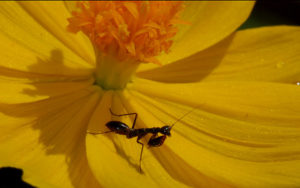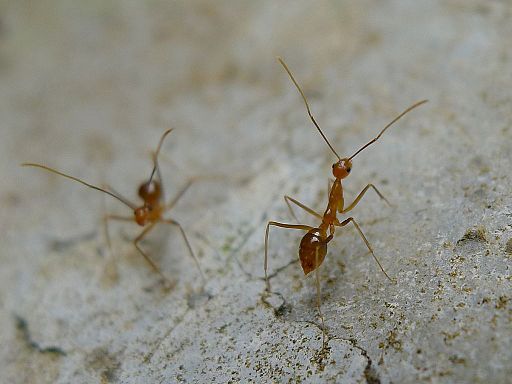
The above image is not an ant, but is a praying mantis juvenile mimicking an ant for its self-protection.
Many types of insects, including beetles and spiders, have evolved to mimic ants to avoid predators.
Ants also are effective defenders of their nests, working together.
But some creatures have developed methods of invading an ant nest without detection, to live on ant larvae and ant food. Sometimes the invader brings about the decimation of the nest.
Four of the top ten ant enemies
Ants are among the most plentiful and formidable creatures on the planet Earth, able to use their vast numbers and collective problem solving skills to defend their nests from even the largest attackers, but nothing in nature is without its enemies, and with their staggering numbers, ants have racked up quite the list of ant-agonists (sorry). Creatures that specialize in living with or living off ants are known as “myrmecophiles,” and while some of them are harmless or even helpful to their ant roommates, others use devious trickery to feed off the colony.
10. Ant-loving Snail
Allopeas Emigration: There are many different insects and arachnids who sneak into ant nests, but it’s a much more unusual lifestyle for a mollusk. The snail Allopeas myrmekophilos uses a tasty-smelling slime to deliberately get itself captured by ants, but once inside the nest, it stops smelling like food and goes completely ignored, living off the colony food supply as a freeloader.
9. Eucharitid Wasp
The closest cousins to the ants, wasps are highly diverse creatures with many specialized lifestyles. This particular species is an ant parasitoid; it leaves its tiny larvae on plants where they attach to passing ants and get carried back to the colony. There, they feed on the ant brood until ready to mature.
8. Oogpister Beetle
This large, predatory ground beetle preys almost exclusively on ants, but doesn’t bother trying to trick them; it storms in to ant territory, gobbles them up in its jaws, and uses its legs to kick away any ants who try to ward it off. Amazingly, the beetle extracts acids from the ants which it can then spray from its abdomen to defend itself from larger predators.
7. Microdon Maggot
Microdon is a Phorid fly, like the common fruit fly, whose strange maggots were once mistaken for a species of slug. With their flattened shield-like bodies and a protective odor, these maggots pretend to be just another part of the ant nest as they prey upon helpless ant larvae.
The above is a sample of what you will find out if you read the source article.
Oh, and about our title question, at the bottom of the source article, you’ll find the answer to the question: Do anteaters really like to eat ants?
Image attribution: Ant-Mantis, via Wikimedia, Bangalore, India
To read about the rest of these unusual ant predators, visit the source article at toptenz.net.



